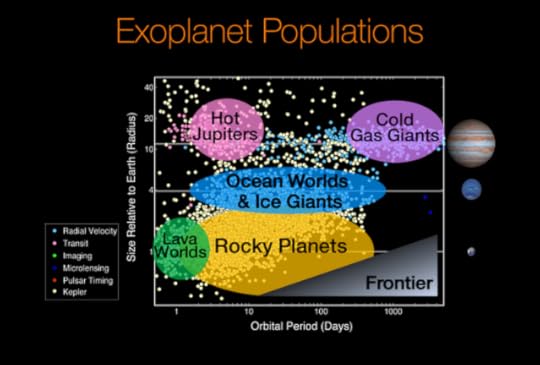Kate Rauner's Blog, page 22
February 16, 2021
Gravity Is Not a Force! #Physics #gravity
Ever hear that there are four fundamental forces of nature: gravitational, electromagnetic, strong nuclear, and weak nuclear? We’re taught that these forces govern how objects interact and how certain particles decay. Ha! We are victims of the over-simplification that most public education and popular media engage in. An over-simplification that makes the math of engineering a lot easier to do (so, hurray) but don’t be fooled. Gravity is not a force. Just ask Albert Einstein.
Okay, Einstein is dead, so you can’t ask him. Watch this You Tube instead. (There are ads embedded in the video – sorry about that, but renting eyeballs makes the world go ’round.)
February 15, 2021
Galileo’s Birthday Commemorated – was he brave? stubborn? whatever else, he was correct #Galileo
Feb 15th is the birthday anniversary of mathematician, physicist, and philosopher Galileo Galilei (1564–1642.)

Galileo was a truly inspirational scientist. Like Darwin, the ideas he put forward, though correct, were met with large amounts of controversy and resistance from the Church. However, he stuck to the scientific method and followed the conclusions the evidence led to. Galileo Day
There’s a quotation attributed to Galileo, a sort of Florentine middle finger to The Church (though even in legend, not spoken to any Church official.) You probably know the story: in 1633 he was forced to recant his statement that the Earth moves around the Sun. The Church opposed revealing his discoveries (which were not disputed by scientists, please note, but by a papal political power broker) to the public.
If you harrumph that he should have stayed true to science, consider that, if he had persisted, the Supreme Sacred Congregation of the Roman and Universal Inquisition would have rewarded him with a nasty death. Reminds me of another quote – If you fight and run away, you live to fight another day.
The story of Galileo’s quote apparently comes from a book published in 1757, (over a hundred years after his death:
The moment he was set at liberty, he looked up to the sky and down to the ground, and, stamping with his foot, in a contemplative mood, said, Eppur si muove, that is, still it moves, meaning the Earth. Wikipedia
From what Wikipedia says, this is unlikely to be true. Just a great quote awarded to a hero from the past. There are crackpots today who claim that they are just like Galileo. Pursuing my stream of consciousness with quotations… that brings to mind another one:
Alas, to wear the mantle of Galileo it is not enough that you be persecuted by an unkind establishment, you must also be right. Robert Park
Mulling over quotations led me to look up Park in Wikipedia. I see that the physics professor died this past April. That is a loss, even if he was not a fan of sending humans into space.
Celebrate today! Despite being blacklisted, Galileo’s work survived. Power brokers can’t murder scientists anymore, and Park left us non-physicists his popular books, like Voodoo Science.
February 12, 2021
Spiders in Space – not science fiction monsters, but real spiders #NASA #ISS #Biology
NASA’s been curious about how spiders might adapt to space for years. Will they build webs and catch prey in zero-g the way they do on Earth? The question has interested certain scientists for a long time. An article on the 2011 experiment with spiders has recently been released. (Yes, it can take a long time to work through all the data from an ISS mission.)
 First spider web in space was earlier, onboard Skylab 3 in the 1970s
First spider web in space was earlier, onboard Skylab 3 in the 1970sResearchers confirmed their prediction that webs made in outer space were more symmetrical and the spiders did not always face downward. Surprisingly, though, they also found that the spiders behaved in a more terrestrial manner when a directional light was introduced. This was unexpected. link.springer, with thanks to Brian Dunning
Perhaps the exploits of arachnauts don’t seem likely to get humanity to Mars, or whatever goal most interests you, but if we’re going to live off-Earth, we’ll need to take other critters with us. This is an interesting start.
Take a Deep Dive into Deep Space
Neat home school resource: zoom-in on the night sky as billions of points of light resolve into galaxies, nebulae and other deep sky objects. The link is here.
 Take a deep dive into deep space at the DESI Legacy Imaging Surveys web site. This is an interactive display using a 10 trillion pixel composite picture of much of the night sky, based on different imaging data sets to create the image. The zoom-in is incredible as the billions of points of light resolve into galaxies, nebulae and other deep sky objects. Some of the datasets even show a spectral display. There are a number of ways to interact with the images including a way to flip back and forth between two images to watch for any objects in motion. Clicking on the screen will bring up options for joining a forum to ask or discuss what you are viewing. There are links to other information about that object or part of the sky.
Take a deep dive into deep space at the DESI Legacy Imaging Surveys web site. This is an interactive display using a 10 trillion pixel composite picture of much of the night sky, based on different imaging data sets to create the image. The zoom-in is incredible as the billions of points of light resolve into galaxies, nebulae and other deep sky objects. Some of the datasets even show a spectral display. There are a number of ways to interact with the images including a way to flip back and forth between two images to watch for any objects in motion. Clicking on the screen will bring up options for joining a forum to ask or discuss what you are viewing. There are links to other information about that object or part of the sky.
The video is a short tour of around Taurus and Orion.

Click here to go…
View original post 30 more words
February 11, 2021
7 More Minutes of Terror! Mars Perseverance Rover to Land – Be Ready #Mars2020 #Mars
Only one week to go! On Feb. 18, 2021, NASA’s Mars Perseverance rover (aka Percy) makes its final descent to the Red Planet, landing via a sky crane. Mars is too far away for mission controllers to help; the car-sized craft’s programming is all it has to rely on. The maneuver’s been used before, in the “seven minutes of terror” that we all endured when Curiosity landed. But still, I’ll be holding my breath (with a few gasps interrupting the seven minutes.)
Here’s what NASA has planned:
The mission will explore Jezero crater, which scientists speculate was a 250 m (820 ft) deep lake about 3.9 billion to 3.5 billion years ago. Jezero today features a prominent river delta where water flowing through it deposited much sediment over the eons, which is “extremely good at preserving biosignatures”. The sediments in the delta likely include carbonates and hydrated silica, known to preserve microscopic fossils on Earth for billions of years. Wikipedia
NASA has a great resource site: download lots of information, learn how to participate and watch the mission, and there are activities for students. The first interplanetary drone helicopter is aboard this mission, and I can’t wait to find out how that works out.
Until humans land on Mars in real-life, we make-do with science fiction. Join settlers in the first, near-future colony. Struggle for survival. Battle the deadly planet and sometimes each other. Set on the real-Mars as science knows the planet, my stories are full of action and suspense mixed with a vision of how you might one day live your life on the Red Planet. Click now and read the individual books at Amazon and other favorite stores, or get the value-priced box set, also available at Amazon and other favorite stores.
February 6, 2021
It’s Springtime on Mars #Mars #science #planets
I’ve never seen an explanation why, but astronomers selected April 11th, 1955 as 0 degrees for year 1 for a Martian calendar, so springtime of Year 36 has arrived.
Year 36
0 degrees — Spring Equinox — February 06 2021
90 degrees — Summer solstice — August 25 2021
180 degrees — Fall Equinox — February 24 2022
270 degrees — Winter Solstice — July 21 2022
Bob’s Spaces
 No, you won’t find this guy tip-toeing through the tulips
No, you won’t find this guy tip-toeing through the tulipsMars is tilted 25.19° to its orbital plane. Compare that to Earth at 23.44° and you’ll see that you’d feel right at home. Well, maybe not so much, given the 2-year long year, low gravity, and lack of atmosphere. Not to mention lack of life. Even if we find evidence of past life or a few microbes hanging on, there will be no tulips. I assume the chart above is for the northern hemisphere. That’s where the earthly British Royal Observatory is located, so it’s sort of a zero point for references. A lot of the structure and nomenclature we (or, me, ’cause I’m American) use in science came to us from Europe, even when the concepts originated elsewhere.
Celebrate the equinox on Mars! Join the first colony in a series that nails it for realism, if I do say so myself.
Until humans land on Mars in real-life, we make-do with science fiction. Set on Mars as science knows the planet, my stories are full of action and suspense mixed with everyday life on the Red Planet. Read the individual books at Amazon and other favorite stores, or get the value-priced box set, also available at Amazon and other favorite stores.
 Read them all today
Read them all today
February 4, 2021
If We Can Do It, They Can Do It #sciku #haiku #exoplanet #poem
If they search for life
Aliens could spot the Earth
See us! We are here!

Line-ups are ideal
So a thousand brethren
See Earth dim the Sun
Thanks to livescience.com for considering whether aliens on other worlds could spot the Earth the way human scientists spot exoplanets.
February 1, 2021
Imbolog 2021
Groundhog Day! There is some scientific rationale to this ritual…
Watch That WoodChuck! On February 2, we watch for the groundhog to emerge for reasons that originate from ancient Celtic tradition. Groundhog Day was known as lmbolog, or sheep’s milk, a time for nurturing young sheep and planting spring crops. The belief arose that if lmbolog were to be sunny and clear, then winter’s effects would endure, foreshadowing a long winter. However, if skies were overcast, then the warmer days of spring would arrive early. To farmers then and today, an early spring means early spring planting and a subsequent early harvest. Often fires were lit to commemorate the event as fires were a sign of warmth and light, both of which increased as days lengthened.
On February 2, we watch for the groundhog to emerge for reasons that originate from ancient Celtic tradition. Groundhog Day was known as lmbolog, or sheep’s milk, a time for nurturing young sheep and planting spring crops. The belief arose that if lmbolog were to be sunny and clear, then winter’s effects would endure, foreshadowing a long winter. However, if skies were overcast, then the warmer days of spring would arrive early. To farmers then and today, an early spring means early spring planting and a subsequent early harvest. Often fires were lit to commemorate the event as fires were a sign of warmth and light, both of which increased as days lengthened. German immigrant farmers are credited with bringing Groundhog Day with them to the United States as they settled in Pennsylvania. To them, February 2 was called Candlemas Day, because of the practice of…
German immigrant farmers are credited with bringing Groundhog Day with them to the United States as they settled in Pennsylvania. To them, February 2 was called Candlemas Day, because of the practice of…
View original post 556 more words
January 29, 2021
Your Photo Can Go To The Moon – First Lunar Time Capsule
A NASA-sponsored company, Astrobotic Technology, plans to launch a mission to the Moon in June, 2021. YouTuber Jimmy Donaldson, also known as MrBeast, has purchased space onboard for a hard drive, and for $10, your photo can go along.
At least 18 payloads expect to travel on the mission, including seven rovers from six countries, instruments from four countries, and other unusual payloads like the hard drive. The commercial space industry has truly arrived when a payload can fly just for fun (and maybe profit.) MrBeast proposes thinking of this as a time capsule. I have no idea who (if anyone) will be able to read the files in the future, but who knows, your photo might someday end up in the history section of a lunar colony’s museum.
I have no financial interest in this deal, and no idea how well (or even if) it will work out, but the shameless commercial plug follows:
January 27, 2021
Saturn’s Moon Titan has Lakes So Deep, Cassini Couldn’t Find Bottom – What’s Down There? #NASA #Saturn #space #scifi
As the data from Cassini’s study of Saturn’s moon, Titan, is studied, more is revealed. And sometimes hidden.
 Atmosphere means balloons could carry probes over Titan
Atmosphere means balloons could carry probes over TitanData from one of the spacecraft’s last flybys of Titan, a large moon with the precursors of life’s chemistry, reveals that a huge lake on the surface called Kraken Mare is more than 1,000 feet ( 300 meters) deep. In fact, the lake is so deep that Cassini’s radar couldn’t probe all the way to the bottom. space.com
Titan is bizarre in its resemblance to Earth, but in a totally off-kilter way. Titan has a dense atmosphere of mostly nitrogen – like Earth’s atmosphere but missing the oxygen that indicates life.
Titan has liquid lakes on its surface, but not water. It’s much too cold for liquid water to exist, so the lakes are methane and ethane, “but current models suggest that the moon should cycle through all of the methane on its surface in only 10 million years, a small fraction of the 4.5-billion-year lifetime of our solar system.” So where’s the methane coming from?
Could there be life in those methane lakes? Is that even possible? Will humans ever step foot on such a profoundly cold and deadly world? NASA would like to return, perhaps with a submarine in twenty or thirty years. Until then, only imagination can take us to Titan.
Join me in a Science Fiction adventure.
Who’d want to spend the rest of their life on a shadowy world of liquid methane lakes?
Shoved into a stasis pod on a hijacked spaceship, Fynn is on his way to Titan. But any vision of utopia is doomed from the start. Under their bizarre leader, the colony erupts as factions clash. Fynn leads his outcast friends in a desperate bid to save all their lives. Click here now.

The recent study of Cassini date was published in December, in the Journal of Geophysical Research: Planets.




